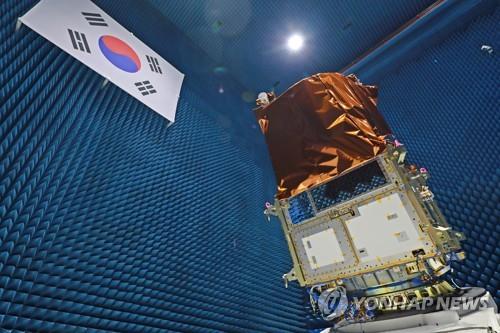Ministry of Science and Technology “planning to determine future launch schedule after completion of cause analysis and inspection”
(Seoul = Yonhap News) Reporter Lee Joo-young = The launch of the next-generation medium-sized satellite 1 scheduled to be launched from the Baikonur Space Center in Kazakhstan at 3:7 p.m. on the 20th (local time) is delayed due to an abnormality found in the launch vehicle. done.

The Ministry of Science and ICT announced that the launch of the’next-generation medium-sized satellite 1′, which was scheduled to be launched on the afternoon of the 20th at the Baikonur Space Center in Kazakhstan, has been temporarily delayed. The picture is the 1st next-generation medium-sized satellite undergoing an electromagnetic environment test. [한국항공우주연구원 제공. 연합뉴스 자료사진. 재판매 및 DB 금지]
The Ministry of Science and ICT announced that a problem was found in the’Soyouth 2.1a’ launch vehicle that was preparing to launch at the Baikonur Space Center on the same day, and that it has delayed the launch schedule to check it.
JSC GlavCosmos, a launch service company for the next-generation medium-sized satellite 1, found a problem in the control system of the top of the launch vehicle (Fregot) during the final inspection of the Soyuz launch vehicle system before launch and delayed the launch schedule.

[과학기술정보통신부 제공. 재판매 및 DB 금지]
The Soyuz 2.1a launch vehicle is a 308t-class rocket consisting of a three-stage liquid rocket (using liquid oxygen/kerosine) and a top (pregat hydrazine/UDMH), and can place 4.8t payloads such as satellites in solar orbit.
In this launch, the next-generation medium-sized satellite 1, a cube satellite developed by domestic university students, and a Japanese satellite are expected to be launched.
The Ministry of Science and ICT explained, “Currently, JSC GlavCosmos is analyzing the cause of the Soyuz projectile’s launch interruption and checking the system to prepare for normal launch.”
Next-generation medium-sized satellite No. 1 moved to the Baikonur Space Center on January 22, and the Korea Aerospace Research Institute’s technical staff completed the preparation for launch, such as functional inspection, fuel injection, and launch vehicle and assembly for more than 50 days.
The next-generation medium-sized satellite 1 was developed with Korea’s own technology, hosted by the Korea Aerospace Research Institute, and participated by domestic aerospace companies in order to use it as a’standard platform’ for a 500kg medium-sized satellite. 157.8 billion won was invested, including the Ministry of Science and ICT’s budget of 118.2 billion won and the Ministry of Land, Infrastructure and Transport of 45.52 billion won.
The satellite is equipped with an optical camera with a resolution of 0.5m in black and white and 2.0m in color. After launch, it is expected to be active in solar synchronous orbits at an altitude of 497.8km and provide precise ground observation images, wide-area agricultural and forest conditions observation images, and water resource observation radar images. do.
Unauthorized reproduction-prohibition of redistribution>
2021/03/20 16:26 sent
